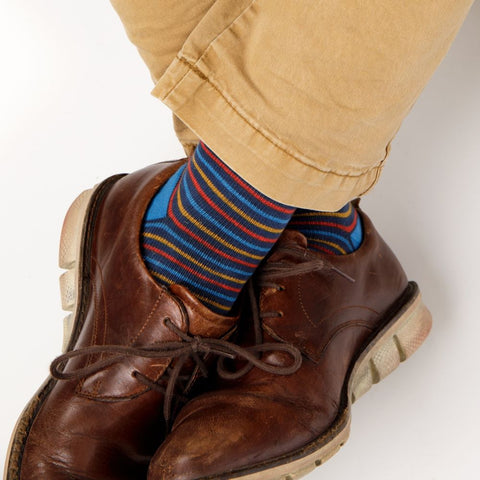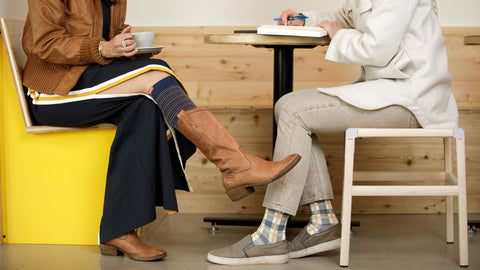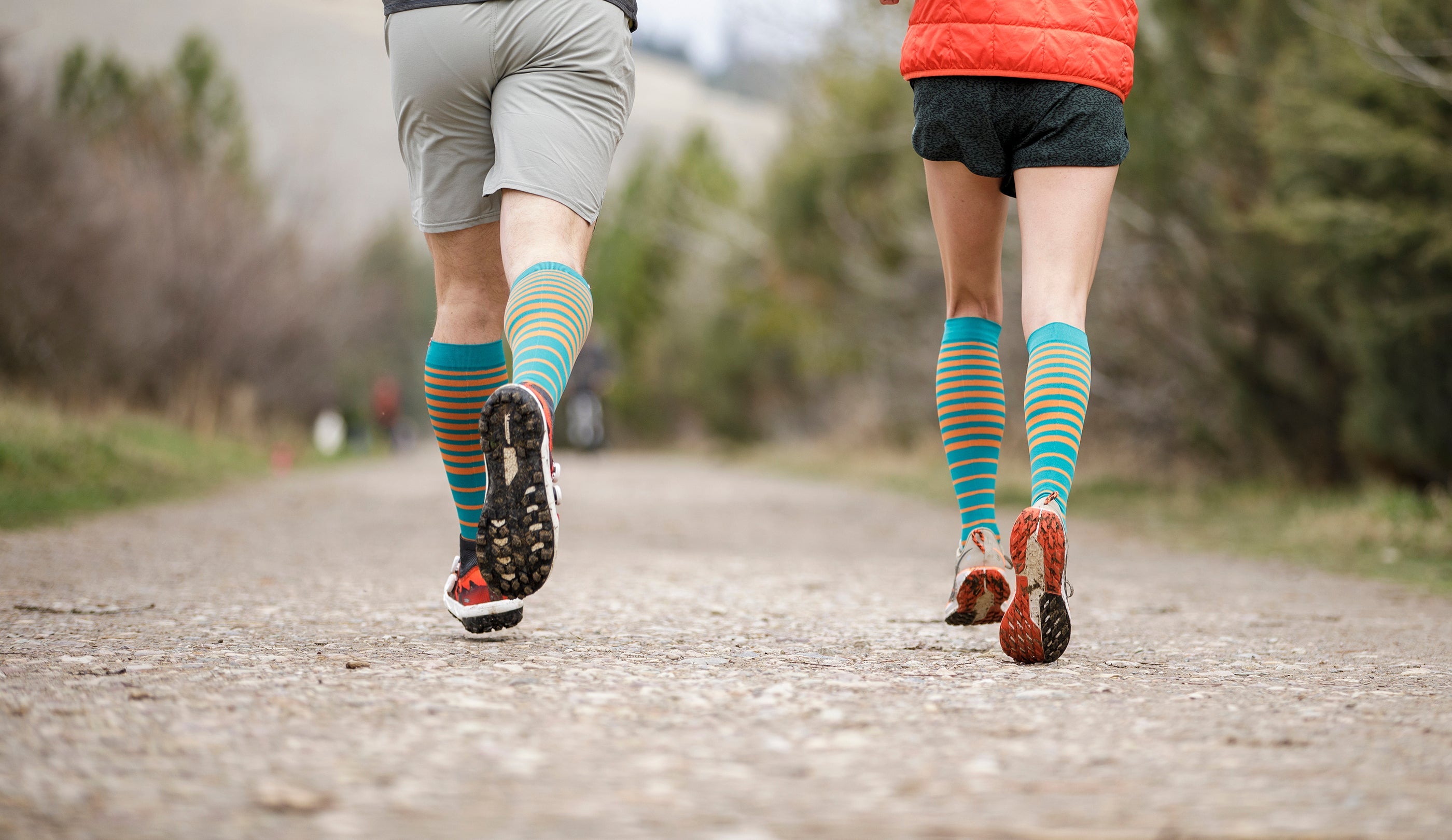Compression Socks for Nocturia Relief: Unlocking Better Sleep
Suffering from nocturia - waking up for frequent nighttime urination - is a poorly understood problem that can significantly affect your sleep quality and wellbeing. It’s important to know that you’re not alone. In fact, waking up more than once a night to go to the bathroom is more common than you think, and frequent nighttime urination increases with age.
So, what causes nocturia and how can you manage nocturia to unlock a better night’s sleep? A well-known scientific article says that nocturia can be caused by many factors. Nocturia can be caused by poor heart health, drinking too much fluids, diabetes, sleep apnea, chronic pain, overactive bladder, and more. This is where the use of compression socks could yield important benefits for helping improve circulation, reduce excess fluid retention in the extremities during the day, and support the health of veins overall.
Read on to see how compression socks can help improve your sleep and reduce problems with nocturia.
Do Compression Socks Help with Nocturia?
Compression socks and stockings are extremely effective at stimulating blood flow and helping support healthy circulation. They reduce swelling in the legs from fluid build-up throughout the day. When it comes to sleeping, it’s a time when the body works to process the fluid accumulated in the extremities, which often leads to the need to get up and use the toilet.
A scientific study from 2022 studied if compression stockings during they day can help people with nocturia. The scientists found that lower limb compression does improve nocturia symptoms to help you sleep better. People with nocturia that wore compression stockings woke up less frequently at night and had almost one more hour of uninterrupted sleep!
Wearing compression socks during the day can help keep fluid moving well throughout the bloodstream, limit blockages, and ensure a better night’s sleep.
Common Causes of Nocturia
So, what causes nocturia and/or the build-up of fluid that leads to frequently waking up to pee at night?
In the short term, nocturia can be caused by:
- Drinking too much shortly before going to bed (especially alcohol or caffeine).
- Some medications like diuretics, lithium, cardiac glycosides, etc.
- “Bad habits” i.e. getting your body used to waking up to “check” if you need to pee.
However, nocturia can be caused by a multitude of longer-lasting causes or conditions, including:
- Leg swelling/edema
- Poor peripheral circulation
- Heart or vascular problems
- Restless leg syndrome
- Diabetes
- Bladder stones or inflammation
- Sleep disorders
- Reduced bladder capacity - often occurring with age
- Pregnancy
There doesn’t appear to be a consensus around one simple cause of nocturia - usually, several factors contribute to this condition.
How Poor Circulation Contributes to Nocturia
People who suffer from poor circulation deal with many unpleasant side effects: cold feet, swelling and discomfort, painful legs, or even varicose veins or blood clots. A malfunctioning circulatory system can also be behind the need to pee frequently at night (otherwise known as nocturia).
Nocturia affects 50 million people in the United States. One scientific review shows that nocturia can be caused by conditions such as diabetes or an overactive bladder. It is also common during pregnancy or when people take in large amounts of fluid throughout the day (which is then passed through the kidneys when they sleep). Importantly, nocturia can be a sign of venous insufficiency.
With venous insufficiency, your legs may swell during the day because water, blood cells, and proteins leak from the veins into the surrounding tissues. The lymphatic system then tries to return this protein (serum) into the bloodstream when your legs are more level with the heart (typically as you lay down to sleep). Since there is less hydrostatic pressure to force the fluid from the veins into the tissues when you lay down (as there would be when you stand up), the lymph fluids drain back into your bloodstream from your legs more easily, which causes the kidneys to become more active.
Your kidneys will then filter excess water from the blood and store it in the bladder as urine. When the bladder is full, you will feel the need to urinate, which wakes you up. A study published in the Journal of Urology found a direct correlation between how much fluid accumulated in patients’ legs and the number of times they need to get up to urinate.
Potential Benefits of Compression Socks for Nocturia
Compression socks provide multiple benefits, like supporting the muscles and massaging sore feet and legs after a long day spent standing or sitting at a desk. The main benefit is the positive effect they have on blood flow, reducing symptoms of nocturia through the therapeutic pressure applied by compression socks.
Improved Circulation
The therapeutic pressure that compression socks apply to the lower legs stimulates blood flow to prevent fluid build-up and reduce swelling. This improves the circulation in the whole body, as graduated stockings and socks actually boost flow upwards towards the heart. As a result, incidents like frequent nighttime urination should decrease.

Reduced Fluid Retention
Through promoting a healthy, constant flow of blood throughout the body, compression socks reduce the risk of fluid buildup. This means less swelling and reduced likelihood of developing edema, among other conditions. Compression socks directly contribute to fighting nocturia caused by fluid retention in the legs.
Support for Venous Insufficiency
A healthy circulatory system allows the veins to carry blood throughout the body without any challenges, which reduces the risk of venous insufficiency. Venous insufficiency, along with edema, high blood pressure, or restless leg syndrome, has been linked to the development of nocturia. Compression socks are effective in managing these and ensuring that blood flow is restored to a healthy level.
When to Wear Compression Socks for Nocturia
A key study investigated the best way to use compression socks for nocturia. The findings showed that wearing lower leg compression during the day reduces the buildup of fluid and swelling in the lower legs. That leads to fewer instances of urination at night and fewer signs of an overactive bladder. Other findings recommend using compression stockings not just during the daytime, but specifically during afternoons and evenings.
It is important to note that researchers have found that, beyond venous insufficiency, nocturia could be caused simply by long-term standing that leads to excess fluid building up in the lower extremities. This is why wearing compression socks throughout the day, especially if your work requires you to be on your feet a lot, could be greatly beneficial.
Choosing the Best Compression Socks for Nocturia
To ensure best results, your compression socks need to apply enough pressure to the limbs to stimulate blood flow and help reduce the fluid build-up that leads to nocturia. However, comfort is also key to improve nocturia symptoms- as you are more likely to wear compression socks if they don’t interfere with your daily activities or are uncomfortable.
Choose Graduated Compression
For better overall circulation, graduated compression is the most effective. This is because graduated compression socks are tighter at the lower end and then slowly release pressure upwards. This means they can stimulate the blood flow towards the heart better and be more efficient at reducing the risk of fluid build-up and of swelling.

Finding the Right Size and Fit
Ensuring that your compression socks fit well is essential to get the benefits we’ve been discussing in this article. Firstly, they need to be comfortable and worn correctly. If you have opted for knee-high socks, always make sure that you pull them up to just under the knee and that the heel and toes are well nestled into their respective folds. You will also need to ensure that there is no folding or bunching along the material, smoothing this carefully when you put on your socks.
But socks need to be the right size, too. We recommend measuring your calf circumference and plotting that against your dress size to find the best fit on our sizing chart. Remember: effective compression will feel tight, but not so much that it’s uncomfortable or that it cuts off your circulation. If you have any doubts, please consult with your doctor.
Finally, when it comes to compression wear, there are different levels of pressure that you can apply to the limbs. The entry-level socks that anyone can wear even for 24 hours at a time are those in the 15-20 mmHg category. Tighter socks are available but are usually prescribed to people who suffer from other medical conditions. You should consult with a medical professional if you feel that 15-20 mmHg does not feel like enough pressure to prove effective.
Style and Material Options
Choosing the right fabric is important for comfort - and there is a good amount of choice:
- Cotton socks are classic for a reason - they come in lots of colors and styles. You can wear them all day long, at work or when at home relaxing. However, we would not recommend cotton for more strenuous exercise; it’s not very good at keeping your feet dry.
- Nylon and moisture-wick nylon socks are sleek, flexible, and great for working out in.
- Merino wool is perfect for keeping your feet warm and dry in any temperatures; we also recommend it for hiking, skiing, and other outdoor activities.
And do not think that you can only go for knee-high classic compression socks for nocturia. If you need to keep your toes well-ventilated or wear your socks with sandals during the day, try out our range of open-toe compression socks. Another alternative for keeping your feet free is our range of compression sleeves, which you can pair with other types of socks while still boosting circulation in the lower legs. Finally, for fuller coverage, you can also opt for compression tights or leggings to help with blood flow and improve nocturia symptoms.
Complementary Strategies for Nocturia Management
A gold-standard study found that compression wear can have a positive impact on nocturia. The frequency of getting up at night decreased for patients who used knee-high compression socks. Wearing a type of garment throughout the day is easy, convenient, and low maintenance, as well. Additionally, here are some other strategies that should help address this condition.
Adjust Your Fluid Intake
As we mentioned before, drinking a lot of fluid (alcohol and caffeine in particular) can lead to episodes of nocturia. The closer to bedtime, the worse it will be - so late nights out are a big cause. You should look to slowly decrease how much you drink as bedtime approaches. Consult with a medical professional if you are unsure what is safe for you.
Maintain a Healthy Weight
Some cases of nocturia are linked with obesity, therefore keeping a healthy weight can reduce your risk of nighttime discomforts.
Elevate the Legs
Another good method of reducing fluid buildup in the legs (aside from wearing compression socks) is to slightly elevate them during your sleep by using a pillow under the lower legs. You could also stretch lightly and place legs above the heart for a few hours before heading to bed after a long day spent on your feet.
Address Underlying Health Conditions
We’ve mentioned above that, although there is no consensus on what causes nocturia, various conditions have been associated with it. This is why it’s important to understand any underlying health problems that could have led to your condition. Manage these with the help of your doctor and you should see a positive change in your sleep quality, too.
When to Be Concerned About Frequent Urination at Night
Nocturia is not a disease, but it could be the side effect of a condition you need to look into. If you find that you often get up to pee several times a night, you should consult with a medical professional who can assess your overall health and advise the best course of action to treat any underlying condition.
References
Weiss J. P. (2012). Nocturia: focus on etiology and consequences. Reviews in urology, 14(3-4), 48–55. Read it here.
Kaga, K., Yamanishi, T., Shibata, C., Kamasako, T., Kaga, M., & Fuse, M. (2022). The Efficacy of Compression Stockings on Patients With Nocturia: A Single-Arm Pilot Study. Cureus, 14(8), e28603. Read it here.
Leslie, S.W., Sajjad, H., & Singh, S. (2023). Nocturia. StatPearls: StatPearls Publishing. Read it here.
Torimoto, K., Hirayama, A., Samma, S., Yoshida, K., Fujimoto, K., & Hirao, Y. (2009). The relationship between nocturnal polyuria and the distribution of body fluid: assessment by bioelectric impedance analysis. The Journal of urology, 181(1), 219–224. Read it here.




















Leave a comment